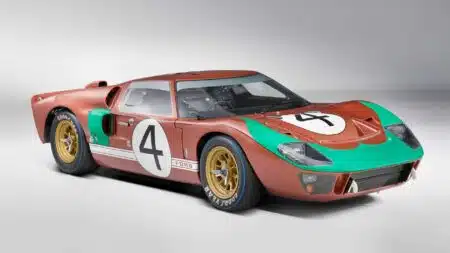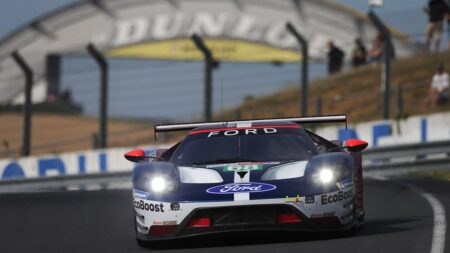
McLaren wants to win 2027 Triple Crown with Le Mans Hypercar
McLaren will enter the Le Mans Hypercar class for the very first time in 2027 – and is gunning to win motor sport's 'Triple Crown' all in one year
On the way to the 2018 Le Mans 24 Hours, this V8-powered Ford Mustang turned more heads than a cavalcade of Porsches – but will it ever compete in the endurance race?
This could have been the poster boy of Ford’s Le Mans return.
Just imagine it. The big-nosed, front-engined, rear-wheel drive Mustang taking on Aston Martin’s Vantage, Ferrari’s 488 and Porsche’s 911 – let alone its big rival from GM, the Corvette.
It wasn’t to be. Rightly, Ford opted to build something completely new that had a heritage just as long as this modern Mustang, the Ford GT. What the GT could provide was a Le Mans history to tap into, and something on which to spend its marketing money. From its 2016 debut, it would have four anniversaries to win on: the 50th anniversary of 1966, ’67, ’68 and, finally, ’69.
That is marketing gold dust the Mustang simply didn’t have.
Not to say the Mustang doesn’t have its own racing pedigree, of course. At home it appeared in Trans-Am – notably with Jerry Titus, Sam Posey, Parnelli Jones and George Follmer until Penske, Mark Donohue and the Camaro took over. In 1988, Scott Pruett claimed the IMSA GTO title, and in the UK Alan Mann Racing won the 1965 British Saloon Car Championship with Roy Pierpoint.
This sixth-generation Mustang is heading to the racetrack itself in the shape of a customer GT4 car, factory-backed programmes in Australian Supercars, and its silhouette returns to NASCAR in 2019. But the Mustang mainly has to do its talking on the road. And it does so, loudly.
There’s a something about a Mustang that stirs something in everyone. Drive a 911 and people glance and nothing more. They’ve become immune to them and the many other £100,000 sports cars on the road. But drive past in a £40,000 Mustang and they look, look again and watch it go by. They even point.
Now, being noticed is not the reason to choose a new car, obviously. But it serves to underline that very relationship we have with Mustangs, or at least certain Mustangs. This modern incarnation is one of those, just like the original early ‘60s and ‘70s Mustangs. Between times – most notably the Fox-based variants – it was more a case of dragging the name through the generations to a point when a true Mustang reappeared. Mustangs became rebadged Capris and Sierras, even being based on a Mazda 6 at one point. When the fifth generation appeared in the 2000s, it resembled a Mustang but it didn’t quite fit. It was a caricature but was critically received well.
The shoe fits now, though, and finally in right-hand drive. It’s bigger, even more purposeful-looking yet the fat has been chiselled off. Its hulking stance is aggressive and inside feels expansive.
Though driving down to Le Mans, when French farmers were reportedly in the midst of a protest that took form of them blocking fuel deliveries to fuel stations, may have been a mistake. The first drive skirting around London’s innermost points on the north circular only confirmed that when the average miles per gallon dropped to a paltry seven.
Seven.
I had been warned but chose to ignore the rest of the editorial desk. This was to be a passage for the car, I persuaded them and myself, showing it what it could have won. Mustangs raced at Le Mans – in 1967 Claude Dubois raced a GT350 and Saleen prepared two in 1997 – but it was never the headline attraction, like the Ford GT has been since its controversial introduction in 2016 (50 years on from its first win, remember).
And it turns out that you can get to Le Mans for an acceptable cost. It averaged around 27mpg on its 800 or so miles, which is respectable for a five-litre V8 that weighs almost two tonnes.
This is the third different car I’ve taken to a third different European race track in a month, and while it can’t match the 911 – we got to Stavelot and back with just one fill up of its 68-litre tank, though the tank was rather dry when we arrived back… – it can match our old long-termer F-Pace. The Jaguar’s 60-litre tank needed refreshing at least three times to and from the Nürburgring. And that’s supposed to be a big family-friendly wagon.
And the Mustang really is a draw for people – they double-take, and kids point and wave. The proof came slowly squeezing through Rouen in a stream of British ‘plates. In front was the latest 911, behind a 997 911. All eyes, every child’s grin, were pointed at the Mustang. A car half the price.
One middle-aged man in a BMW even thrust a thumb of his window. At least two bikers did similarly. Its mystique has somehow been preserved.
As for the car itself, its hefty V8 makes its presence felt wherever you go. There is a constant and pleasing gurgling that resonates from beneath its bonnet, and every blip of the throttle wakes it into a full-on growl – and a few notches drop on the miles-to-empty counter.
Its boot is spacious, seemingly bigger than the F-Pace’s. It’s comfortable, its gearbox fine (this was an automatic), albeit a tad sleepy in ‘normal’ mode but eagerly awaiting you in ‘sport’. It’s no match for the Porsche PDK, but the Mustang is – again – less than half the price.
The Mustang is in a strange place in the market: not suited to traffic (so not an ideal daily driver) but brilliant anywhere else.
Could it form the basis of Ford’s entry into the GTP/nameless prototype division? Yes, but it won’t. The Ford GT has that job lined up, already barely more than a prototype it doesn’t take too much imagination to envision it as a DPi/GTP car. But, for that, Ford needs IMSA and WEC to align, because it wants to win – understandably – Daytona and Le Mans with the same car.
Which it did with the GT40, of course. And the marketing cycle begins again.
The big, bruising Mustang will have to remain a brilliant bridesmaid to the GT.

McLaren will enter the Le Mans Hypercar class for the very first time in 2027 – and is gunning to win motor sport's 'Triple Crown' all in one year

A Ford GT40 MkII which managed 12 laps at the famous 1966 Le Mans 24 Hours has become been auctioned for a record amount

Two of racing's biggest rivals are on collision course once more, with the Ford v Ferrari battle for overall Le Mans victory due to resume in 2027 after six decades — and Ford is already talking up the fight

Ford will develop a new top-tier sports car to compete for overall victory in the Le Mans 24 Hours and the World Endurance Championship Hypercar class from 2027 onwards, aiming to continue where its GT40 left off in the 1960s